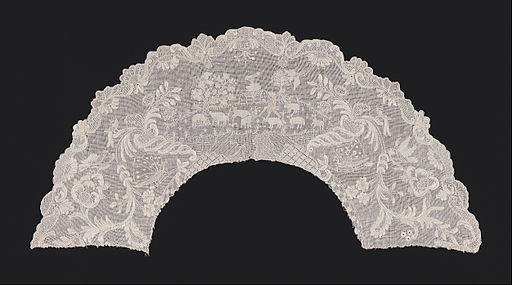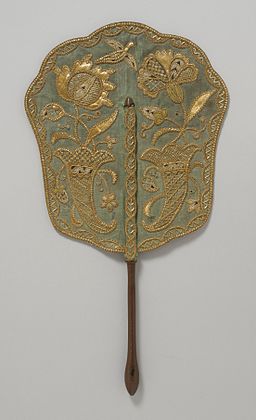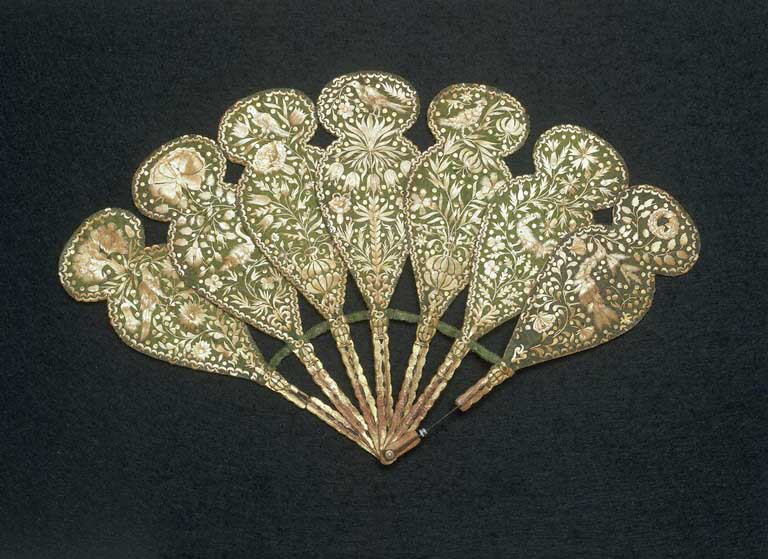by Maria Grace
"Men have the sword, women have the fan and the fan is probably as effective a weapon!" --Joseph Addison
For centuries fans have appeared in paintings as the quintessential fashion accessory. They are so ubiquitous they call for a closer examination.
 Makers of fans
Makers of fans
Originating with the guilds of Europe, City Livery Companies have existed in London for over one thousand years. These companies had the power to set wages, train apprentices, and control standards and imports of goods. A guild of fan makers existed as early as 1670 and was formed into a formal company, charted by Queen Anne, in 1709.
By 1747, over 800 members were registered with the Worshipful Company of Fan Makers, with approximately twenty apprentices completing their seven year apprenticeships as fan makers a year. The membership even included some women such as Sarah Ashton who published at least thirteen designs for engraved fans. In 1809, the company was granted livery of scarlet gowns trimmed with fur for their Masters and wardens.
Anatomy of a Fan
Although several types of fans exist, they share in common many of the same structures.
Sticks
A fan’s sticks formed the basic structure of the fan. In the 18th and early 19th century they might be made of wood, bone, horn, ivory, metal, mother of pearl or tortoise shell. The sticks might be carved, pierced or painted, especially along the lower edge. The sticks might be arranged such that ‘daylight’ might be seen between them, or to form a continuous surface. In more elaborate designs, the carvings on the edges of the sticks might form patterns or figures visible only when the fan was folded.
Leaf or mount

Fans might consist only of sticks, or they might have a leaf or mount applied to narrow sticks. Leaves might be made of silk, kid (leather), crape, lace, paper or a form of vellum known as ‘chicken skin’(which was not a tanned chicken hide). Unless a fan was made of chicken skin, the mount was usually made of two pieces, one glued to each side of the sticks. Fan mounts were often elaborately decorated.
Ribs
When a leaf or mount was used, ribs were the thin sticks to which the mount was glued.
Guard
The sticks on the ended might be slightly thicker and more highly decorated. When the fan was closed, these offered some protection to the sticks and leaf within.
Rivet/Pivot
The rivet or pivot holds the fan together is often set with a decorative gem. Brackets to attach the fan to a chatelaine might also be present.
Types of Fans
Several different forms of fans existed, going in and out of style like most fashion accessories.
 Fixed
Fixed
The earliest fans, often made of wood or feathers attached to a handle, did not fold. Thus, they were called fixed. Their popularity faded with the convenience of the folding fan.
Folding
Several forms of folding fans exist.

Brise’
Brise’ fans consist of sticks only with no leaf. Individual sticks that get wider from the rivet to the top are fastened together with a ribbon or decorative fabric band. The sticks might be decorated individual with painting, gilding, piercing or carving, or together to form a scene or image when opened. Inexpensive brise’ fans might be made of wood. Ivory, tortoise shell and mother of pearl could be very fashionable.
 Pleated
Pleated
Pleated fans are the most common folding fans. Sticks are held together at the bottom rivet and a leaf or mount is attached to them. Leaves might be made from paper, silk or other fabric, kid, lace, feathers or vellum.
Cockade fans are a type of pleated fan in which the stiff pleated leaf is attached to two sticks. The sticks open full circle and fasten together to form a handle.
are pleated fans with a leaf of multiple, separate strips. These leaf strips were made of chicken skin (vellum) since it was the only material strong enough to withstand the wear and tear in such narrow bands.
Decoration
While useful, fans are most often considered a fashion accessory and prized for their beauty.
 Master artists and individual ladies alike decorated fans with paintings on silk and paper leaves. Landscapes were popular themes, as were the depiction of persons. Biblical and mythological themes were favored by some, while others leaned toward caricatures. As demand for decorative fans increased, designs were printed, rather than painted or paper or silk, permitting the production of less expensive fans.
Master artists and individual ladies alike decorated fans with paintings on silk and paper leaves. Landscapes were popular themes, as were the depiction of persons. Biblical and mythological themes were favored by some, while others leaned toward caricatures. As demand for decorative fans increased, designs were printed, rather than painted or paper or silk, permitting the production of less expensive fans.
References
Maria Grace is the author of Darcy's Decision, The Future Mrs. Darcy, All the Appearance of Goodness, and Twelfth Night at Longbourn and Remember the Past. Click here to find her books on Amazon. For more on her writing and other Random Bits of Fascination, visit her website. You can also like her on Facebook, follow on Twitter or email her.
"Men have the sword, women have the fan and the fan is probably as effective a weapon!" --Joseph Addison
For centuries fans have appeared in paintings as the quintessential fashion accessory. They are so ubiquitous they call for a closer examination.
 Makers of fans
Makers of fansOriginating with the guilds of Europe, City Livery Companies have existed in London for over one thousand years. These companies had the power to set wages, train apprentices, and control standards and imports of goods. A guild of fan makers existed as early as 1670 and was formed into a formal company, charted by Queen Anne, in 1709.
By 1747, over 800 members were registered with the Worshipful Company of Fan Makers, with approximately twenty apprentices completing their seven year apprenticeships as fan makers a year. The membership even included some women such as Sarah Ashton who published at least thirteen designs for engraved fans. In 1809, the company was granted livery of scarlet gowns trimmed with fur for their Masters and wardens.
Anatomy of a Fan
Although several types of fans exist, they share in common many of the same structures.
Sticks
A fan’s sticks formed the basic structure of the fan. In the 18th and early 19th century they might be made of wood, bone, horn, ivory, metal, mother of pearl or tortoise shell. The sticks might be carved, pierced or painted, especially along the lower edge. The sticks might be arranged such that ‘daylight’ might be seen between them, or to form a continuous surface. In more elaborate designs, the carvings on the edges of the sticks might form patterns or figures visible only when the fan was folded.
Leaf or mount

Fans might consist only of sticks, or they might have a leaf or mount applied to narrow sticks. Leaves might be made of silk, kid (leather), crape, lace, paper or a form of vellum known as ‘chicken skin’(which was not a tanned chicken hide). Unless a fan was made of chicken skin, the mount was usually made of two pieces, one glued to each side of the sticks. Fan mounts were often elaborately decorated.
Ribs
When a leaf or mount was used, ribs were the thin sticks to which the mount was glued.
Guard
The sticks on the ended might be slightly thicker and more highly decorated. When the fan was closed, these offered some protection to the sticks and leaf within.
Rivet/Pivot
The rivet or pivot holds the fan together is often set with a decorative gem. Brackets to attach the fan to a chatelaine might also be present.
Types of Fans
Several different forms of fans existed, going in and out of style like most fashion accessories.
 Fixed
Fixed The earliest fans, often made of wood or feathers attached to a handle, did not fold. Thus, they were called fixed. Their popularity faded with the convenience of the folding fan.
Folding
Several forms of folding fans exist.

Brise’
Brise’ fans consist of sticks only with no leaf. Individual sticks that get wider from the rivet to the top are fastened together with a ribbon or decorative fabric band. The sticks might be decorated individual with painting, gilding, piercing or carving, or together to form a scene or image when opened. Inexpensive brise’ fans might be made of wood. Ivory, tortoise shell and mother of pearl could be very fashionable.
 Pleated
Pleated Pleated fans are the most common folding fans. Sticks are held together at the bottom rivet and a leaf or mount is attached to them. Leaves might be made from paper, silk or other fabric, kid, lace, feathers or vellum.
Cockade fans are a type of pleated fan in which the stiff pleated leaf is attached to two sticks. The sticks open full circle and fasten together to form a handle.
 Cabriolet fans
Cabriolet fans
are pleated fans with a leaf of multiple, separate strips. These leaf strips were made of chicken skin (vellum) since it was the only material strong enough to withstand the wear and tear in such narrow bands.Decoration
While useful, fans are most often considered a fashion accessory and prized for their beauty.
 Master artists and individual ladies alike decorated fans with paintings on silk and paper leaves. Landscapes were popular themes, as were the depiction of persons. Biblical and mythological themes were favored by some, while others leaned toward caricatures. As demand for decorative fans increased, designs were printed, rather than painted or paper or silk, permitting the production of less expensive fans.
Master artists and individual ladies alike decorated fans with paintings on silk and paper leaves. Landscapes were popular themes, as were the depiction of persons. Biblical and mythological themes were favored by some, while others leaned toward caricatures. As demand for decorative fans increased, designs were printed, rather than painted or paper or silk, permitting the production of less expensive fans. References
- http://candicehern.com/collections/08/fans.htm
- http://www.marquise.de/en/1700/faecher.shtml
- When Chicken-Skin Wasn’t , 13 December 2013 by Kathryn Kane
- http://www.inkwellinspirations.com/2012/11/the-language-of-fan.html, November 19, 2012
- http://www.fanmakers.com/text.aspx?id=16
Maria Grace is the author of Darcy's Decision, The Future Mrs. Darcy, All the Appearance of Goodness, and Twelfth Night at Longbourn and Remember the Past. Click here to find her books on Amazon. For more on her writing and other Random Bits of Fascination, visit her website. You can also like her on Facebook, follow on Twitter or email her.

How beautiful!
ReplyDeleteFantastic blog!
ReplyDeleteFascinating and informative post . Thank you. I learned alot
ReplyDeleteThey are so ubiquitous they call for a closer examination.
Nice
Fans, like flowers must of had a language too. Fun to think of all the different flutterings to be seen at a theater sending messages ....much like our tweets today!
Lovely post. Lovely to look at as well as to read.
ReplyDeleteThank you for such an informative, lovely post.
ReplyDelete